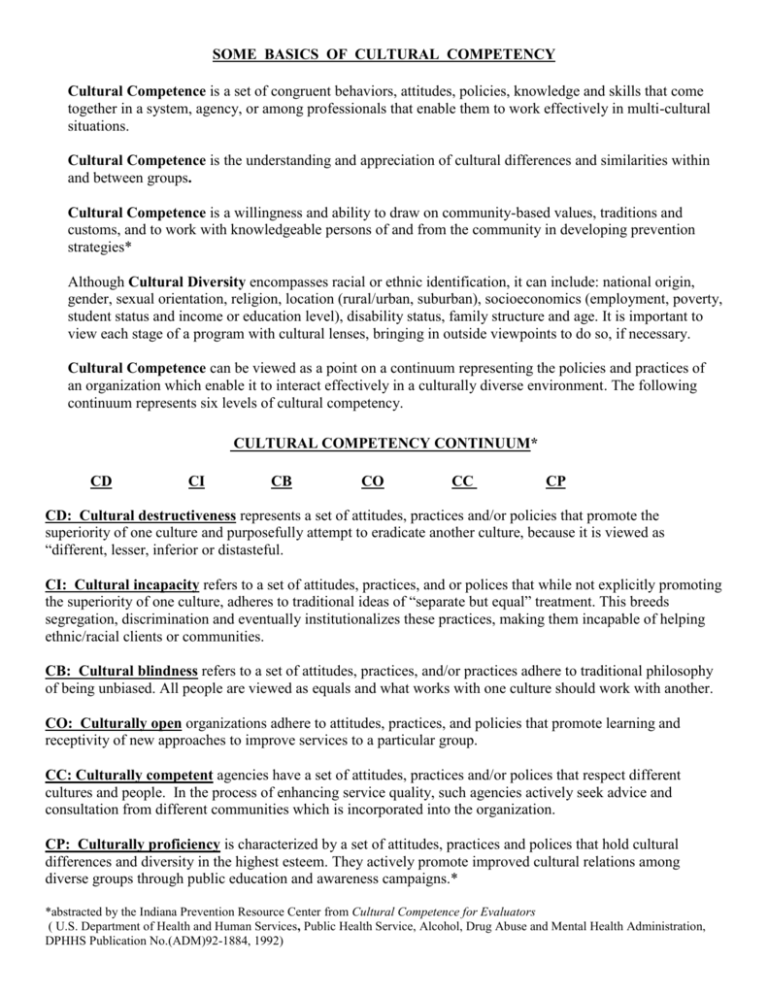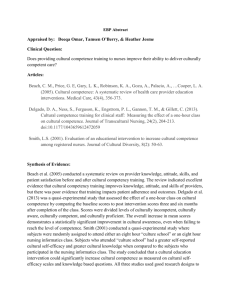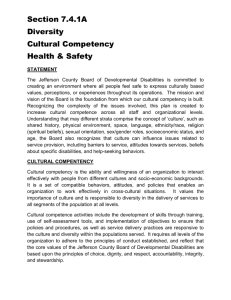Some Basics of Cultural Competency
advertisement

SOME BASICS OF CULTURAL COMPETENCY Cultural Competence is a set of congruent behaviors, attitudes, policies, knowledge and skills that come together in a system, agency, or among professionals that enable them to work effectively in multi-cultural situations. Cultural Competence is the understanding and appreciation of cultural differences and similarities within and between groups. Cultural Competence is a willingness and ability to draw on community-based values, traditions and customs, and to work with knowledgeable persons of and from the community in developing prevention strategies* Although Cultural Diversity encompasses racial or ethnic identification, it can include: national origin, gender, sexual orientation, religion, location (rural/urban, suburban), socioeconomics (employment, poverty, student status and income or education level), disability status, family structure and age. It is important to view each stage of a program with cultural lenses, bringing in outside viewpoints to do so, if necessary. Cultural Competence can be viewed as a point on a continuum representing the policies and practices of an organization which enable it to interact effectively in a culturally diverse environment. The following continuum represents six levels of cultural competency. CULTURAL COMPETENCY CONTINUUM* CD CI CB CO CC CP CD: Cultural destructiveness represents a set of attitudes, practices and/or policies that promote the superiority of one culture and purposefully attempt to eradicate another culture, because it is viewed as “different, lesser, inferior or distasteful. CI: Cultural incapacity refers to a set of attitudes, practices, and or polices that while not explicitly promoting the superiority of one culture, adheres to traditional ideas of “separate but equal” treatment. This breeds segregation, discrimination and eventually institutionalizes these practices, making them incapable of helping ethnic/racial clients or communities. CB: Cultural blindness refers to a set of attitudes, practices, and/or practices adhere to traditional philosophy of being unbiased. All people are viewed as equals and what works with one culture should work with another. CO: Culturally open organizations adhere to attitudes, practices, and policies that promote learning and receptivity of new approaches to improve services to a particular group. CC: Culturally competent agencies have a set of attitudes, practices and/or polices that respect different cultures and people. In the process of enhancing service quality, such agencies actively seek advice and consultation from different communities which is incorporated into the organization. CP: Culturally proficiency is characterized by a set of attitudes, practices and polices that hold cultural differences and diversity in the highest esteem. They actively promote improved cultural relations among diverse groups through public education and awareness campaigns.* *abstracted by the Indiana Prevention Resource Center from Cultural Competence for Evaluators ( U.S. Department of Health and Human Services, Public Health Service, Alcohol, Drug Abuse and Mental Health Administration, DPHHS Publication No.(ADM)92-1884, 1992) CULTURAL COMPETENCY RATING Coalition/project site _______________________ Workgroup_______________________________ Date____________________________________ First, define the pertinent cultural groups, that is those groups likely to be involved within your community. Who is affected and who needs to be involved in the planning, implementation, and reinforcement of changes? (age, major ethnic groups, socio-economic status (employed/unemployed, student status, poverty, education or income levels), location (rural or urban, or particular geographic area), family structure, sexual orientation, etc.) ________________________________________ ________________________________________ ________________________________________ ________________________________________ In keeping with the descriptions just cited, how would this workgroup rate itself on Cultural Competency at this time? Through group consensus, rate it by circling one of the numbers below, corresponding with one of six levels of Cultural Competency: A Cultural Competency Continuum CD CI CB CO CC CP 0 1 2 3 4 5 This is a good opportunity for discussion of Cultural Competency. Your workgroup might discuss What has been your experience as part of a group or workplace characterized by any of the ratings, listed above, on Cultural Competency? What does ‘tokenism’ mean? What makes for true representation of a group? How would you rate this workgroup? What positive elements of Cultural Competency does it already have? What doesn’t it have? The following checklist includes some, but not all items you may want to consider in rating your workgroup. To improve its rating on Cultural Competency what steps could this workgroup take? A summary of discussion may be helpful. *partially abstracted by the Indiana Prevention Resource Center from Cultural Competence for Evaluators ( U.S. Department of Health and Human Services, Public Health Service, Alcohol, Drug Abuse and Mental Health Administration, DPHHS Publication No.(ADM)92-1884, 1992) CULTURAL COMPETENCY COMPONENTS Assessments Assessment workgroups include members of pertinent cultural groups Data collected is relevant to cultural groups within the assessment Data sources are culturally acceptable (focus groups, gatekeeper information, elders, interviews with specific sub-groups, as well as traditional sources) Data sources are culturally meaningful. Capacity Building Training and Outreach workgroups include members of pertinent cultural groups Capacity building methods are culturally appropriate (consider community values, appropriate roles by gender/age, community resources, social hierarchy) Staff hired are members of pertinent cultural groups Staff, leaders, messengers are credible people to cultural group Strategic Planning Strategic Planning workgroups include members of pertinent cultural groups Goal focus is culturally appropriate (definition of problems, successes, progress) The project is implemented in the language of cultural groups Relationship to the Community The service location is within the community being served Outreach is to the served community (flyers, posters, networking, interviewing, media) The existence of a credible network within cultural groups The project is viewed as community or locally driven Training Training is done by pertinent cultural groups (ethnic/youth/low-income/users) Cultural training is provided for staff and council/workgroups Training is done in a culturally sensitive manner (communication/participation styles) Training material is culturally appropriate (language, style, symbols, readability levels) Program Practices Program activities/ practices are culturally acceptable (family/gender roles and activities; e.g. coed swimming may not be acceptable within certain cultural groups) Program and practices are multilingual where necessary Time concept is culturally appropriate (flexible hours/appointments/home visits) Members of cultural groups conduct registration/intake Match client/ direct service staff on pertinent cultural backgrounds Agency environment reflects culture (art, furnishings, setting) Evaluation Evaluators/planners and workgroups include members of pertinent cultural groups Evaluation plan and research tools are culturally appropriate (concepts/measures/methods) Determine whether assessment, capacity building and strategic planning incorporate culturally relevant elements There is cultural input into interpretations of findings (e.g. community-accepted definitions of health and sickness, as well as causality) Written reports are respectful of and approved by all cultural groups (non-judgmental) Permission is obtained from cultural/community members before releasing any findings All cultural groups are acknowledged for their contributions to a project (for participation, contributions, data resource, time and expertise) -Checklist designed by the Indiana Prevention Resource Center






